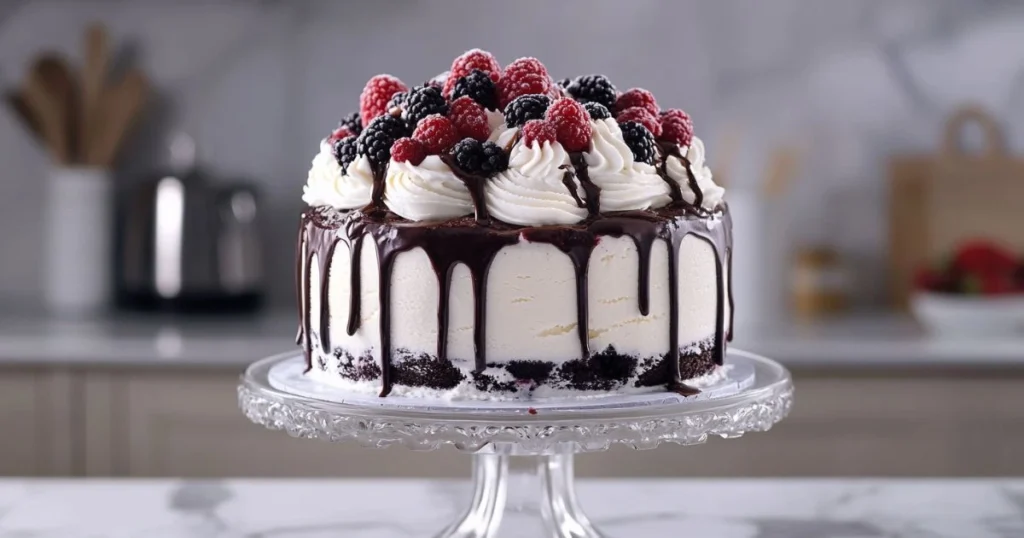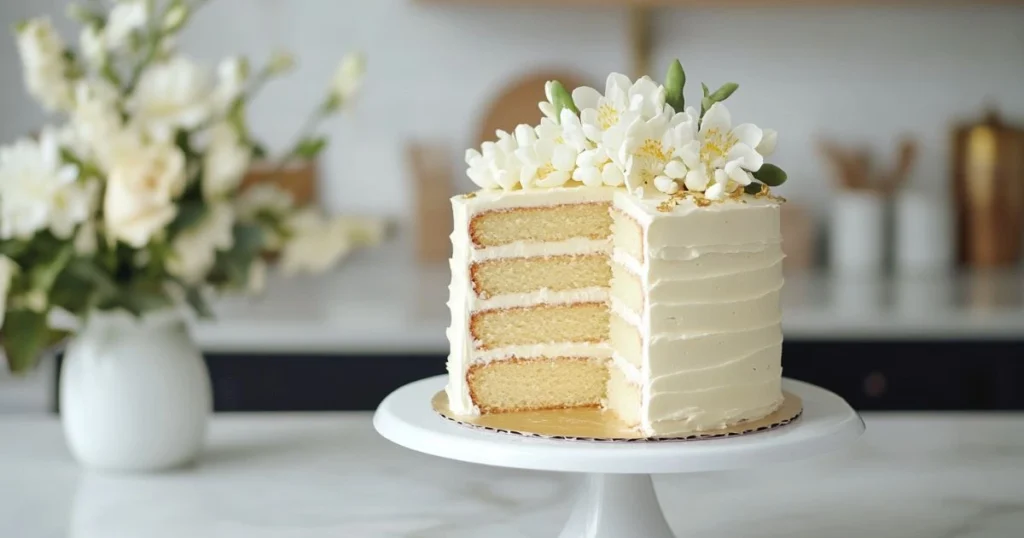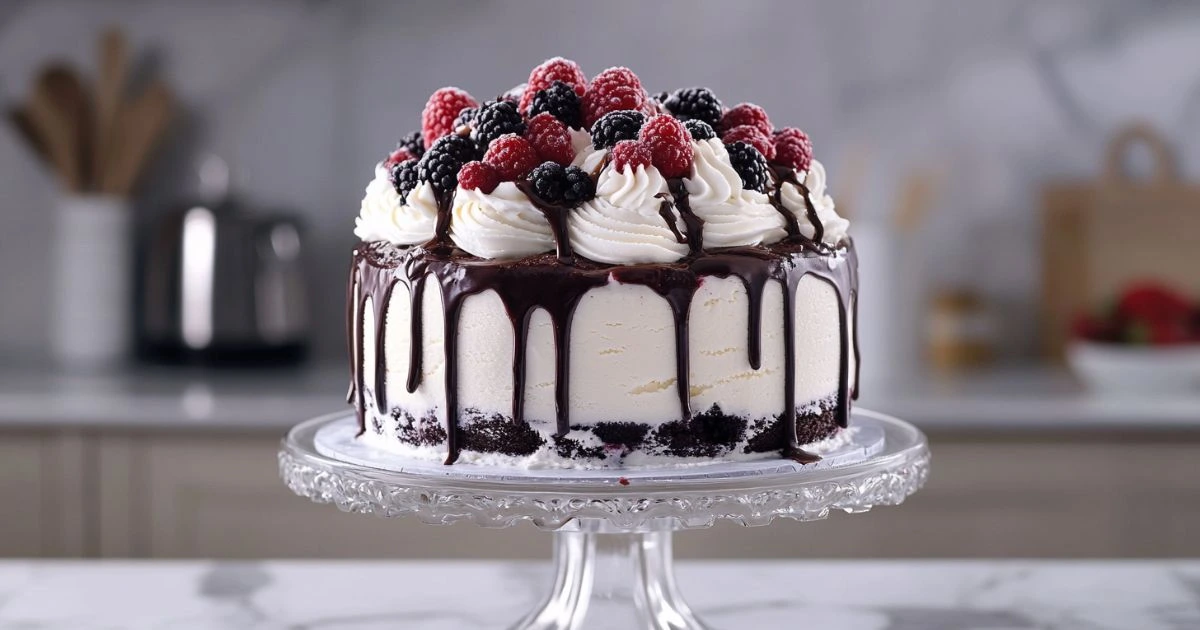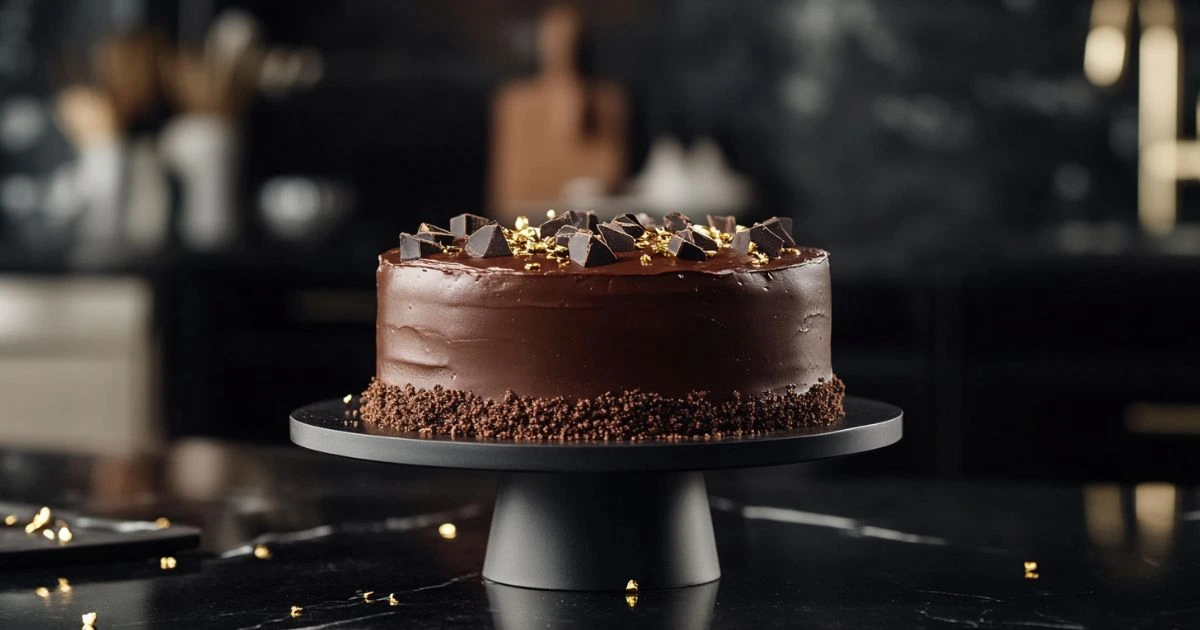Imagine enjoying a slice of moist cake that’s perfect for your taste buds and doesn’t trigger any dietary sensitivities. Many of us have been on a quest to bake delicious treats that are healthy and flavorful. Whether it’s a birthday, a holiday, or just a treat for yourself, we all deserve to enjoy tasty, easy gluten free desserts.
This guide offers easy gluten free desserts with dairy free frosting ideas to change your baking game. You’ll find treats like a 3 ingredient banana nice-cream for summer and vegan chocolate chip cookies. There are also recipes like berry fruit salad with whipped coconut cream and creamy avocado chocolate mousse. These are simple to make and full of flavor.
Exploring these tasty options, you’ll learn about using almond flour, coconut flour, and oat flour. These ingredients add different textures and tastes to your gluten free cakes. You’ll also see how dairy free milk alternatives like almond milk and coconut milk are used to keep the recipes dairy-free.
These cakes are sweetened with maple syrup, honey, and dates instead of refined sugar. This makes them healthier. Coconut oil, avocado oil, applesauce, and chia eggs keep the cakes moist and full of wholesome goodness.
Get ready to find a variety of gluten-free and dairy-free cake recipes. You’ll discover vanilla cake, pineapple upside-down cake, chocolate fudge cake, and carrot cake. Baking can be a joy, especially when you’re making dishes that are healthy and delicious. So, let’s dive into these 10 easy gluten free desserts and dairy-free desserts delights and show off your baking skills!
What is Gluten Free Cake?
Gluten free cakes are a hit in today’s world of gluten free and vegan diets. They use flours like almond, coconut, or oat instead of wheat. This makes them a tasty treat for many.
Definition and Ingredients
Gluten free cakes are made with a mix of flours to match regular cake texture. White rice flour is often the base, mixed with potato or oat flour for better taste and texture. Because these flours soak up more liquid, recipes need more liquid and leavening agents to get the right consistency.
Common Misconceptions
Many think gluten free cakes are dry and tasteless. But, today’s gluten free cake mixes make moist and tasty cakes. Making these cakes is also easier than you might think, with the right mix and a bit of patience.
Health Benefits
Choosing gluten free cakes has many health perks, especially for those with gluten intolerance or celiac disease. Using dairy free frosting helps those with dairy allergies too. The variety of flours used also means more nutrients than wheat flour.
Here’s a quick summary of gluten free cakes:
| Aspect | Details |
|---|---|
| Flours Used | Almond, Coconut, Oat, White Rice, Potato |
| Additional Ingredients | Extra Liquid, Leavening Agents |
| Misconceptions | Dryness, Lack of Flavor, Difficulty |
| Health Benefits | Improved Digestion, Nutritional Diversity |
Popular Types of Gluten Free Cakes
Exploring gluten free cakes opens up a world of delicious desserts. Each type offers unique textures and flavors. They’re perfect for any occasion, from casual gatherings to grand celebrations.
Almond Flour Cakes
Almond flour cakes are known for their moist texture and nutty flavor. Ground almonds act as a natural binder, making the cake soft and fluffy. They’re not only tasty but also packed with protein.
These cakes are lower in carbs than traditional cakes. You can add orange zest or overripe bananas for a unique twist. Almond flour cakes are great for afternoon tea or dinner parties.
Coconut Flour Cakes
Coconut flour cakes have a denser texture and sweeter taste. They’re perfect for heavier cakes and pair well with tropical flavors. Using five egg whites makes them light and airy.
Try different flavors like lemon with coconut flour cakes. Using high-quality ingredients like Bob’s Red Mill 1:1 Baking Flour ensures a delicious cake.
Legacy of Traditional Cakes
Traditional cakes can be made gluten free without losing their flavors. Try a gluten free chocolate cake with xanthan gum or a lemon drizzle cake with mashed potatoes. A gluten free ice cream cake is also a great option.

Modern takes on classic recipes, like a gluten free vanilla cake, are perfect for special occasions. The updated method in June 2024 makes baking easier. These cakes stay moist for days with proper storage.
Whether it’s for everyday dessert or a special occasion, there’s a gluten free cake recipe for you.
Essential Tips for Baking Gluten Free Cakes
Baking a gluten-free dairy-free cake is exciting and challenging. Follow these tips to improve your baking skills. You’ll make delicious, easy gluten free desserts.
Ingredient Substitutions
Choosing the right ingredients is key for a great gluten-free dairy-free cake. There are three main types of gluten free flours: rice flour, potato starch, and purpose-made mixes.
- Rice flour: Light and fine, perfect for cakes and cookies.
- Potato starch: Adds moisture and a chewy texture.
- Purpose-made gluten-free mixes: Blends like Bob’s Red Mill, Cup 4 Cup, and King Arthur are easy to use but may need some tweaking.
Xanthan gum is a common binder in gluten free baking. It helps the cake stay structured and not crumbly.
Measuring Techniques
Getting the measurements right is crucial in gluten free baking. Use a kitchen scale to weigh flours for accuracy. Letting the gluten free batter rest for about 30 minutes before baking helps the flour absorb moisture. This prevents a gritty texture.
Preventing Dryness
Gluten free flours soak up more moisture than wheat flour. To avoid dryness, add moist ingredients like pureed fruit, yogurt, or extra eggs. Also, using protein-rich ingredients like eggs, yogurt, and buttermilk helps keep the cakes moist.
Make sure your batter is well-hydrated for a tender and moist cake. Many recipes suggest adding an extra egg or two. This not only adds moisture but also acts as a binder, improving the cake’s texture.
| Moisture-Adding Ingredients | Purpose |
|---|---|
| Pureed Fruit | Increases moisture and adds natural sweetness. |
| Yogurt | Improves texture and enriches flavor. |
| Extra Eggs | Acts as a binder and enhances moisture. |
By focusing on these details, you can make a gluten free dairy free cake that’s both tasty and moist. Experimenting with these key principles will help you create a variety of easy gluten free desserts.
Delicious Dairy Free Frosting Options
Looking for the perfect *dairy free frosting* to go with a gluten free cake? It can make your dessert even better. There are many options to choose from, each catering to different tastes and dietary needs. Here are three tasty choices:
Coconut Cream Frosting
Coconut cream frosting is creamy and has a tropical taste. You need coconut milk, powdered sugar, and vanilla extract to make it. Whip the cream until it’s stiff, then mix in the sugar and vanilla. It’s a great match for any *gluten free cake*, adding a light and refreshing touch.
Avocado Chocolate Frosting
Avocado chocolate frosting is a healthier option. It uses avocados instead of butter, making it creamy and nutritious. Mix avocados with cocoa powder, sugar, and vanilla until smooth. It’s a rich and indulgent *dairy free frosting* for a gluten free cake.
Cashew Cream Frosting
Cashew cream frosting is smooth and slightly sweet. Soak cashews in water, then blend with lemon juice, maple syrup, and vanilla. It’s a creamy and ethical *dairy-free frosting* that pairs well with a *gluten free cake*.
Here’s a quick guide to compare these frostings:
| Frosting Type | Base Ingredient | Flavor Profile | Ideal Pairing |
|---|---|---|---|
| Coconut Cream Frosting | Coconut milk | Light and tropical | Any gluten free cake |
| Avocado Chocolate Frosting | Avocados | Rich and creamy | Gluten free chocolate cake |
| Cashew Cream Frosting | Cashews | Subtle and sweet | Gluten free vanilla cake |
Flavor Combinations to Elevate Your Gluten Free Cake
Adding new flavors to your gluten free cake can make it even better. Whether it’s for a special event or just a treat, the right mix can make it stand out. It adds depth and complexity to your dessert.
Citrus and Herb Blends
Try mixing citrus with herbs for a bright and refreshing taste. Lemon and rosemary or lime and basil are great choices. They make your cake lighter and more flavorful.
An orange zest with thyme is another great option. It adds a subtle yet sophisticated taste that’s sure to impress.
Rich Chocolate Pairings
If you love intense flavors, rich chocolate pairings are perfect. Adding nuts like almonds or hazelnuts makes the cake more textured and crunchy.
Dark chocolate with berries like raspberries or cherries is also amazing. It balances the chocolate’s richness with a fruity acidity, making it a luxurious treat.
Fragrant Spice Infusions
Spices can take your gluten free cake to new heights. Cinnamon, cardamom, and vanilla add warmth and complexity. They turn simple recipes into exotic delights.
Try ginger and cloves for a holiday cake or nutmeg with pumpkin. These spices not only enhance flavor but also make your desserts more enjoyable.
- Use bright citrus like lemon or lime to break the density of gluten-free cakes.
- Pair rich chocolates with nuts or berries for texture and flavor contrast.
- Spice infusions such as cinnamon, cardamom, or nutmeg add warmth and complexity.
These combinations show how versatile gluten-free cakes can be. Each bite is memorable and enjoyable. From citrus to spices, these flavors can turn your desserts into culinary masterpieces.
| Flavor Combination | Ingredient Details |
|---|---|
| Lemon and Rosemary | 1 tbsp lemon zest, 1 tsp chopped rosemary |
| Chocolate and Hazelnut | 1 cup ground almonds, 1/2 cup chopped hazelnuts |
| Ginger and Clove Spices | 1 tsp ground ginger, 1/2 tsp ground cloves |
Step-by-Step Recipe for a Basic Gluten Free Cake
Looking for a simple gluten free cake recipe? You’re in the right spot. This basic recipe is great for those avoiding gluten or dairy. It’s easy to make and always turns out right.
Ingredients You’ll Need
Get your ingredients ready for this gluten free cake mix:
- 2 cups of all-purpose gluten free flour blend
- 1/2 cup granulated sugar
- 2 teaspoons baking powder
- 1/2 teaspoon sea salt
- 1/4 cup melted butter
- 1/4 cup avocado oil
- 2 large room temperature eggs
- 2/3 cup dairy free milk (such as almond or oat milk)
- 1 tablespoon vanilla extract
- 1/3 cup sprinkles (optional)
Mixing Instructions
Good mixing is key to avoid a dense cake:
- In a bowl, mix the gluten-free flour, sugar, baking powder, and sea salt.
- In a separate bowl, combine the melted butter, avocado oil, eggs, dairy-free milk, and vanilla extract.
- Slowly incorporate the wet ingredients into the dry mixture, stirring lightly until everything is just blended—avoid overmixing!
- If you’re feeling festive, fold in some sprinkles for a fun touch.
Baking Time and Temperature
Follow these steps for the best results:
- Preheat your oven to 350°F (175°C).
- Prepare a 6-inch cake pan by greasing it and lining it with parchment paper.
- Pour the batter into the pan, smoothing the top for even baking.
- Bake for about 45 minutes, or until a toothpick inserted into the center emerges clean.
Cooling and frosting
Allow the cake to cool in the pan for 10 minutes before carefully transferring it to a cooling rack. Let it cool completely before frosting to ensure the icing sets beautifully.
This gluten-free, dairy-free cake is a perfect choice for celebrations. What occasion will you bake this for? 😊
For extra moisture, use vegetable oil instead of canola oil, which is good for your heart.
| Ingredient | Quantity | Calories per Serving |
|---|---|---|
| All-purpose gluten-free flour blend | 2 cups | 60 |
| Granulated sugar | 1/2 cup | 97 |
| Baking powder | 2 teaspoons | 0 |
| Sea salt | 1/2 teaspoon | 0 |
| Melted butter | 1/4 cup | 51 |
| Avocado oil | 1/4 cup | 43 |
| Eggs (room temperature) | 2 large | 156 |
| Dairy-free milk | 2/3 cup | 27 |
| Vanilla extract | 1 tablespoon | 18 |
| Sprinkles (optional) | 1/3 cup | 33 |
Creative Toppings for Your Gluten Free Desserts
Decorating your gluten free ice cream cake or other desserts can make them stand out. Adding different toppings can really enhance your treats.
Fresh Fruits and Edible Flowers
Use fresh fruits like peaches, blueberries, strawberries, and apples for their vibrant colors and sweetness. Edible flowers like pansies and marigolds add beauty and a light flavor. They’re perfect for gluten-free ice cream cakes and other desserts.
Crunchy Nuts and Seeds
Adding nuts and seeds gives your desserts a nice crunch. Almonds, pistachios, and sunflower seeds are great choices. Many gluten-free recipes already include these, making them easy to add.
Vegan Chocolate Drizzle
A vegan chocolate drizzle adds a luxurious touch to any dessert. It’s perfect for cakes, cookies, and muffins. Try our vegan dessert options for a rich and inclusive treat.
| Recipe | Calories | Fat (g) | Cholesterol (mg) | Sodium (mg) | Carbohydrates (g) | Sugars (g) | Protein (g) |
|---|---|---|---|---|---|---|---|
| GF Red Velvet Cake | 455 | 20 | 78 | 355 | 66 | 51 | 5 |
| Gluten Free Sandwich Bread | 110 | 4 | 27 | 95 | 17 | 3 | 4 |
| Gluten Free Oatmeal Cookies | 74 | 4 | 14 | 82 | 10 | 5 | 1 |
| Gluten Free Zucchini Bread | 228 | 12 | 24 | 158 | 30 | 18 | 3 |
| Gluten Free Chocolate Cake | 310 | 17 | 0 | 339 | 41 | 26 | 3 |
| GF Vanilla Cupcakes | 284 | 13 | 50 | 214 | 40 | 31 | 3 |
| Gluten Free Blueberry Muffins | 251 | 9 | 52 | 214 | 41 | 20 | 3 |
| Cornbread | 308 | 13 | 70 | 545 | 43 | 9 | 7 |
| Pumpkin Pie | 361 | 16 | 122 | 271 | 49 | 34 | 7 |
| Gluten-Free Pumpkin Bread | 195 | 8 | 23 | 204 | 31 | 20 | 2 |
| Socca | 113 | 6 | 0 | 298 | 12 | 2 | 4 |
How to Store and Preserve Gluten Free Cakes
Keeping your gluten free cake fresh is key. Proper storage prevents drying out or spoilage. Follow these tips to keep your gluten free dairy free cake delicious and fresh.
Best Storage Practices
Always cool your gluten-free cake completely before storing. This stops moisture from making the cake soggy. Use airtight containers to keep air out, which can dry out the cake. At room temperature, your cake can last up to 3 days. Refrigeration can extend this to about a week.
Freezing Tips
Freezing is great for keeping gluten free cakes fresh longer. Cool the cake completely, then wrap it tightly in plastic wrap. Put it in a freezer-safe bag. Let it thaw at room temperature before serving. This keeps your cake moist and flavorful.
Shelf Life Considerations
The shelf life of gluten free cakes depends on the ingredients. They generally last less than regular cakes because they lack gluten. For the best taste and texture, eat them fresh. Gluten-free breadcrumbs and granola can last up to six months in the freezer.
Keep gluten free cake mixes at 15-25°C for best quality. This ensures they stay fresh. Note that baking times are important. For example, a gluten-free vanilla cake takes about 40 minutes to prepare and bake.
Final Thoughts on Baking Gluten Free Desserts

Baking gluten free doesn’t mean you have to miss out on tasty desserts. Starting a new diet opens up a world of new tastes and textures. With a bit of effort and creativity, you can make delicious treats that fit many diets.
Embracing Dietary Changes
Starting to bake gluten free is a fun journey. You’ll need to swap out eggs, sugar, and flour to keep your cakes tasty and right. Using Bob’s Red Mill 1-to-1 Gluten Free Baking Flour makes things easier. But, making your own mixes lets you control the taste and texture better.
Encouragement for Experimentation
The kitchen is your place to play with gluten free desserts. Try new things and see what works for you. Adding room-temperature eggs and neutral oils to your chocolate cake can really help. Don’t be afraid to try different things like almond milk or flax-egg. Sharing your creations can inspire and support others.
Final Recipe Recap
Looking back at the recipes, remember how versatile gluten free baking is. Each recipe is a chance to make it your own. Remember to measure right, don’t overmix, and use the right pans. Whether it’s a simple sponge or a fancy layer cake, you can make it delicious. Keep your treats fresh and don’t worry about common problems. With these tips, you’ll soon be a pro at making easy gluten free desserts.
FAQ
What are some easy gluten-free desserts with dairy-free frosting ideas?
Try banana nice cream, berry fruit salad with whipped coconut cream, or chocolate avocado mousse. These desserts are both gluten and dairy free. They don’t lose out on taste.
What is a gluten-free cake?
Gluten-free cake uses flours like almond, coconut, or oat flour instead of wheat. These flours are safe for those with gluten issues. They taste and feel like regular cakes.
Are there health benefits to gluten-free cakes?
Yes, gluten-free cakes can help with digestion for those who can’t handle gluten. They also offer a wider range of nutrients from different flours like almond and coconut.
What types of flour are commonly used in gluten-free cakes?
Almond flour makes cakes moist and nutty. Coconut flour makes them sweeter and denser. Both are favorites in gluten-free baking.
How can I ensure my gluten-free cakes aren’t dry?
To avoid dryness, make sure they’re well-hydrated. Add ingredients like applesauce or yogurt. They keep the cakes moist and delicious.
What are some dairy-free frosting options?
Choose from coconut cream frosting, avocado chocolate frosting, or cashew cream frosting. Each offers a unique taste and texture.
What are creative flavor combinations for gluten-free cakes?
Try citrus and herb blends for a fresh taste. Pair rich chocolate with nuts or berries for depth. Spice infusions like cinnamon or cardamom add warmth and complexity.
What ingredients are essential for a basic gluten-free cake?
You’ll need gluten-free flour blend, xanthan gum, and a non-dairy milk like almond or oat milk. Proper mixing and baking are crucial for the right texture.
How can I creatively top my gluten-free desserts?
Top your desserts with fresh fruits, edible flowers, nuts, seeds, and vegan chocolate drizzle. These add flavor and make them look great.
What are the best practices for storing gluten-free cakes?
Keep cakes in airtight containers after they cool. For longer storage, wrap them tightly in freezer-safe wrap. But, they taste best when eaten fresh.

Basic Gluten-Free Cake with Dairy-Free Frosting
Ingredients
For the Cake:
- 2 cups all-purpose gluten-free flour blend
- ½ cup granulated sugar
- 2 tsp baking powder
- ½ tsp sea salt
- ¼ cup melted butter or coconut oil
- ¼ cup avocado oil
- 2 large eggs room temperature
- ⅔ cup dairy-free milk almond, oat, or coconut milk
- 1 tbsp vanilla extract
- Optional: ⅓ cup sprinkles for decoration
For Dairy-Free Frosting:
Coconut Cream Frosting:
- 1 can of chilled coconut milk only the thick cream portion
- 2 cups powdered sugar
- 1 tsp vanilla extract
Instructions
For the Cake:
Preheat the Oven:
- Preheat to 350°F (175°C). Grease a 6-inch cake pan and line it with parchment paper.
Mix the Dry Ingredients:
- In a large bowl, whisk together gluten-free flour, sugar, baking powder, and sea salt.
Prepare Wet Ingredients:
- In a separate bowl, mix melted butter, avocado oil, eggs, dairy-free milk, and vanilla extract.
Combine:
- Gradually pour the wet ingredients into the dry mixture. Stir until just combined—avoid overmixing. If using sprinkles, gently fold them in at this stage.
Bake:
- Pour the batter into the prepared pan. Smooth the top and bake for 40-45 minutes or until a toothpick inserted in the center comes out clean.
Cool:
- Let the cake cool in the pan for 10 minutes, then transfer to a wire rack to cool completely before frosting.
For the Coconut Cream Frosting:
- Chill the can of coconut milk overnight. Scoop out the thick cream portion.
- In a mixing bowl, whip the coconut cream until fluffy.
- Gradually add powdered sugar and vanilla extract, whipping until smooth and creamy.
Assembly:
- Spread the frosting evenly over the cooled cake. Garnish with fresh fruits, nuts, or edible flowers for extra flair.
Notes
Storage Tips
- Room Temperature: Store in an airtight container for up to 3 days.
- Refrigeration: Keep refrigerated for up to a week; bring to room temperature before serving.
- Freezing: Wrap slices in plastic wrap and store in a freezer-safe bag for up to 3 months. Thaw at room temperature.

